

Compact Muon Solenoid
LHC, CERN
| CMS-PAS-BPH-15-002 | ||
| Measurement of the Λb polarization and the angular parameters of the decay Λb→J/ψ(μ+μ−)Λ0(pπ−) | ||
| CMS Collaboration | ||
| August 2016 | ||
| Abstract: We present a measurement of the Λb polarization based on an angular analysis of the decay Λb→J/ψ(μ+μ−)Λ0(pπ−), using data from pp collisions at √s= 7 TeV and 8 TeV collected with the CMS detector. A transverse Λb polarization of 0.00 ± 0.06 (stat) ± 0.02 (syst) is measured. | ||
|
Links:
CDS record (PDF) ;
inSPIRE record ;
CADI line (restricted) ;
These preliminary results are superseded in this paper, PRD 97 (2018) 072010. The superseded preliminary plots can be found here. |
||
| Figures | |

png pdf |
Figure 1:
Definition of the angles used to describe the Λb→J/ψ(→μ+μ−)Λ0(→pπ−) decay. |
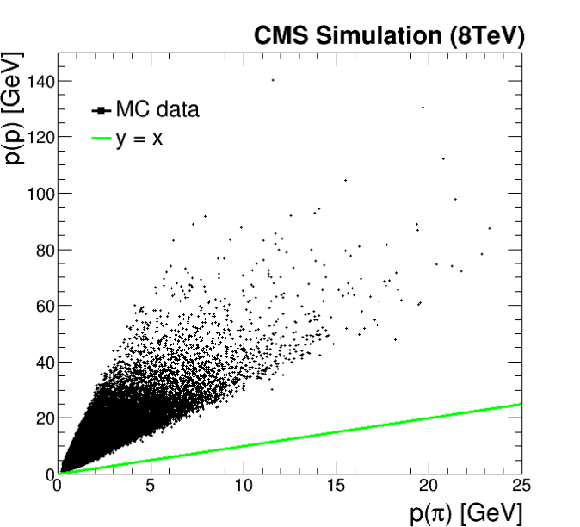
png pdf |
Figure 2:
Distribution of the p vs π momentum obtained from the simulation of Λb→J/ψΛ(pπ−) (and complex conjugate) decays. Events lie always above the green line, ie., the p+ (p−) momentum is always greater than π− (π+) momentum. |

png pdf |
Figure 3-a:
Invariant mass distribution of Λb (a and c) and ¯Λb (b and d) candidates in (a-b) 2011 and (c-d) 2012 samples. The solid blue line represents the fit result. The signal (background) projection is shown with a dashed (dot-dashed) red (blue) line. |
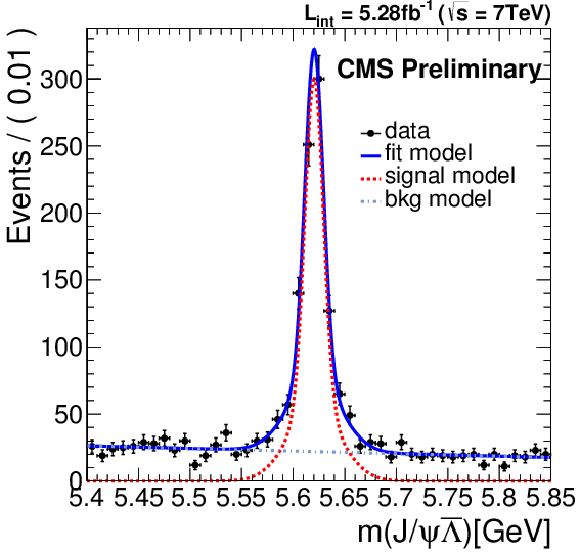
png pdf |
Figure 3-b:
Invariant mass distribution of Λb (a and c) and ¯Λb (b and d) candidates in (a-b) 2011 and (c-d) 2012 samples. The solid blue line represents the fit result. The signal (background) projection is shown with a dashed (dot-dashed) red (blue) line. |
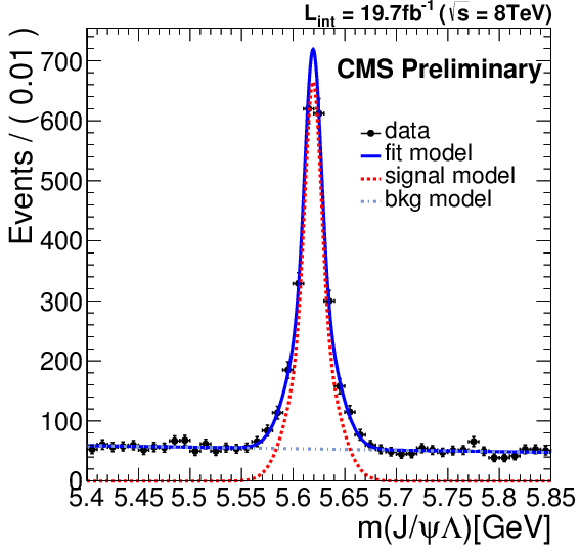
png pdf |
Figure 3-c:
Invariant mass distribution of Λb (a and c) and ¯Λb (b and d) candidates in (a-b) 2011 and (c-d) 2012 samples. The solid blue line represents the fit result. The signal (background) projection is shown with a dashed (dot-dashed) red (blue) line. |
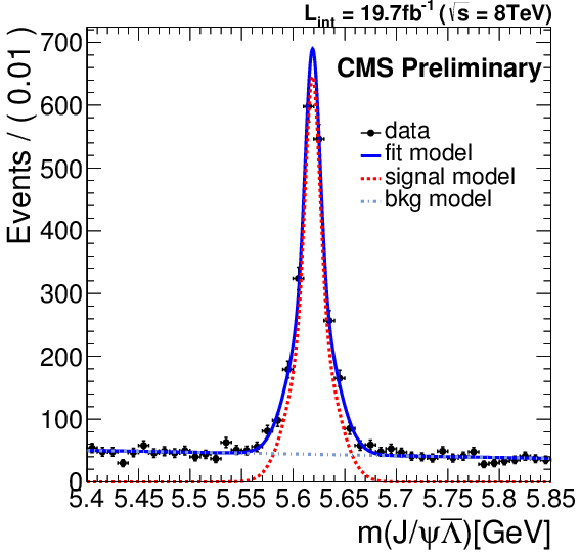
png pdf |
Figure 3-d:
Invariant mass distribution of Λb (a and c) and ¯Λb (b and d) candidates in (a-b) 2011 and (c-d) 2012 samples. The solid blue line represents the fit result. The signal (background) projection is shown with a dashed (dot-dashed) red (blue) line. |

png pdf |
Figure 4-a:
Angular efficiencies for cosθΛ, cosθp, cosθμ (from a to c) obtained from simulated Λb→J/ψΛ0. The angular efficiencies are parametrized with Chebychev polynomials and are fitted simultaneously to the three angular distributions. |

png pdf |
Figure 4-b:
Angular efficiencies for cosθΛ, cosθp, cosθμ (from a to c) obtained from simulated Λb→J/ψΛ0. The angular efficiencies are parametrized with Chebychev polynomials and are fitted simultaneously to the three angular distributions. |
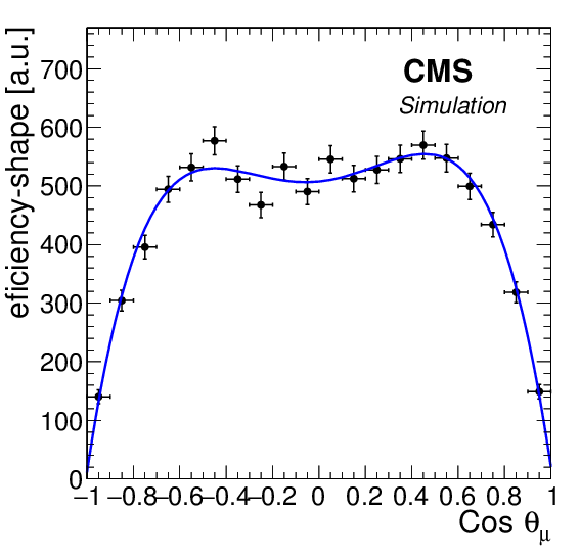
png pdf |
Figure 4-c:
Angular efficiencies for cosθΛ, cosθp, cosθμ (from a to c) obtained from simulated Λb→J/ψΛ0. The angular efficiencies are parametrized with Chebychev polynomials and are fitted simultaneously to the three angular distributions. |

png pdf |
Figure 5-a:
Angular background distributions obtained from the mass sidebands are shown from left to right for cosθΛ, cosθp and cosθμ. The solid blue lines are the results of the fits. |
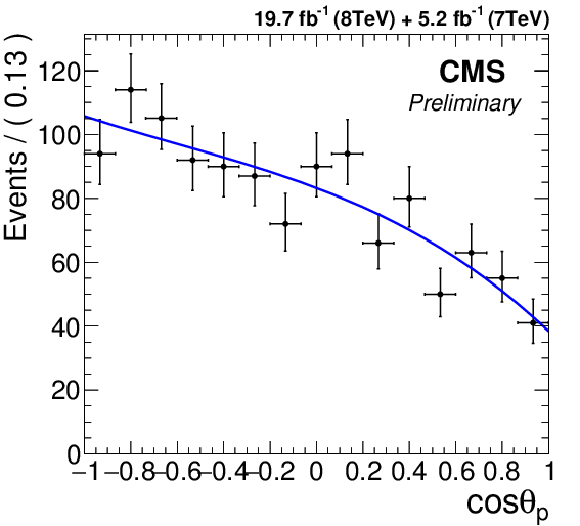
png pdf |
Figure 5-b:
Angular background distributions obtained from the mass sidebands are shown from left to right for cosθΛ, cosθp and cosθμ. The solid blue lines are the results of the fits. |
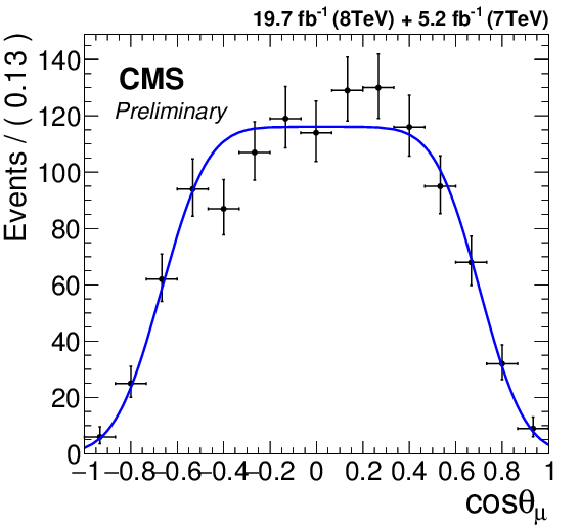
png pdf |
Figure 5-c:
Angular background distributions obtained from the mass sidebands are shown from left to right for cosθΛ, cosθp and cosθμ. The solid blue lines are the results of the fits. |
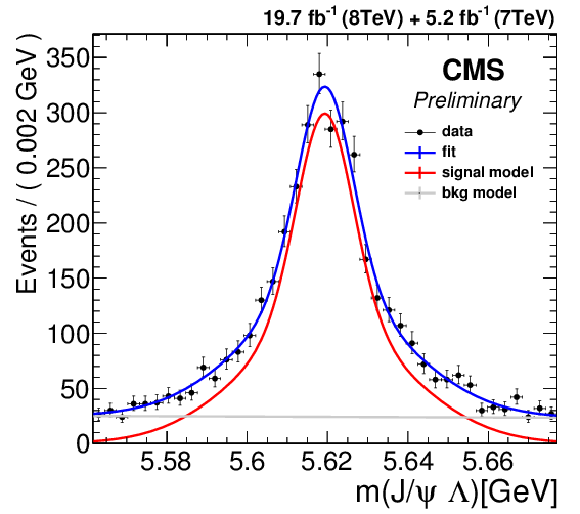
png pdf |
Figure 6-a:
Distributions of m(J/ψΛ), cosθp, cosθΛ, cosθμ (from a to d) for Λb candidates in 2011 and 2012 datasets in m(J/ψΛ)∈[5.56,5.68], with fit results superimposed. The signal (background) component is shown in red (gray). |
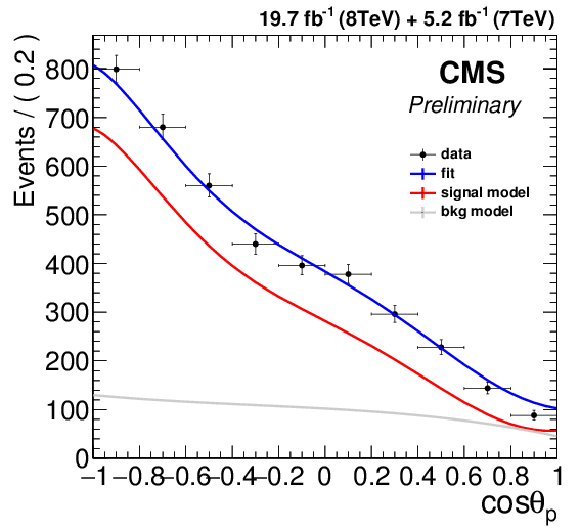
png pdf |
Figure 6-b:
Distributions of m(J/ψΛ), cosθp, cosθΛ, cosθμ (from a to d) for Λb candidates in 2011 and 2012 datasets in m(J/ψΛ)∈[5.56,5.68], with fit results superimposed. The signal (background) component is shown in red (gray). |
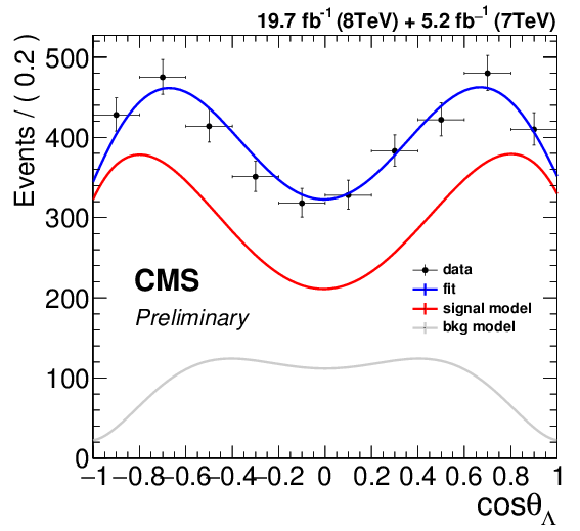
png pdf |
Figure 6-c:
Distributions of m(J/ψΛ), cosθp, cosθΛ, cosθμ (from a to d) for Λb candidates in 2011 and 2012 datasets in m(J/ψΛ)∈[5.56,5.68], with fit results superimposed. The signal (background) component is shown in red (gray). |
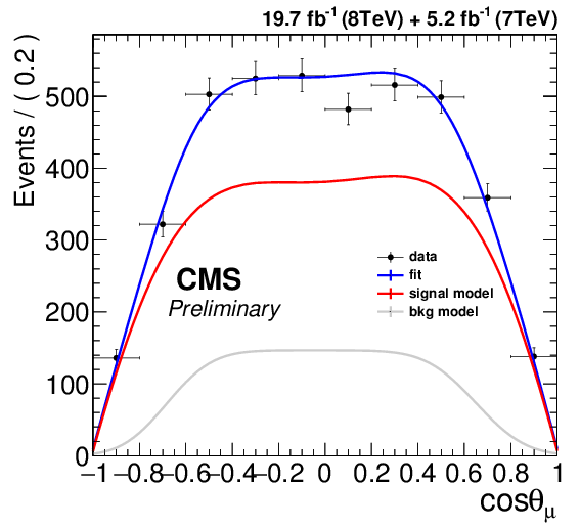
png pdf |
Figure 6-d:
Distributions of m(J/ψΛ), cosθp, cosθΛ, cosθμ (from a to d) for Λb candidates in 2011 and 2012 datasets in m(J/ψΛ)∈[5.56,5.68], with fit results superimposed. The signal (background) component is shown in red (gray). |
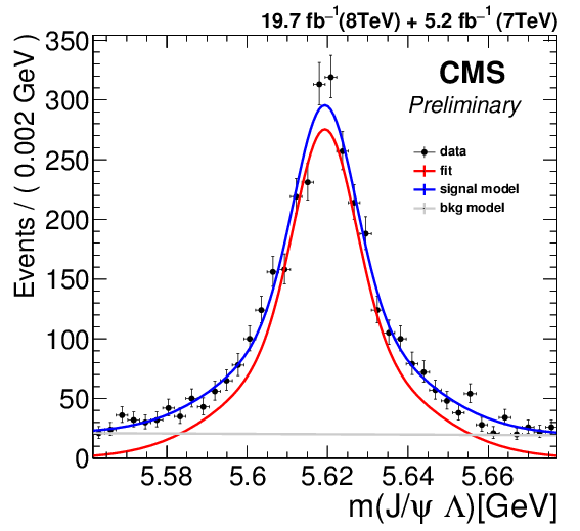
png pdf |
Figure 7-a:
Distributions of m(J/ψ¯Λ), cosθp, cosθΛ, cosθμ (from a to d) for ¯Λb candidates in 2011 and 2012 datasets in m(J/ψ¯Λ)∈[5.56,5.68], with fit results superimposed. The signal (background) component is shown in red (gray). |
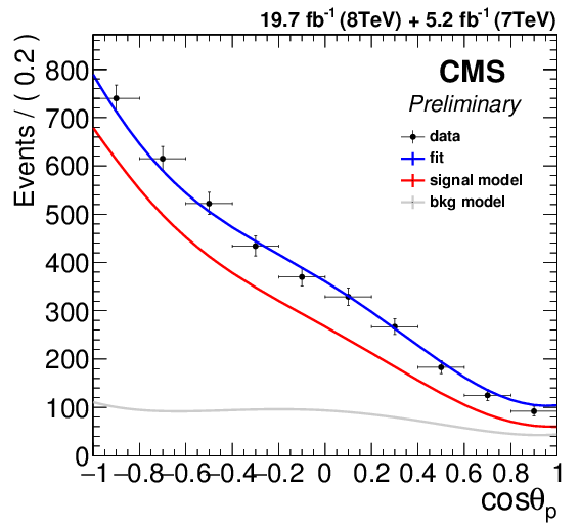
png pdf |
Figure 7-b:
Distributions of m(J/ψ¯Λ), cosθp, cosθΛ, cosθμ (from a to d) for ¯Λb candidates in 2011 and 2012 datasets in m(J/ψ¯Λ)∈[5.56,5.68], with fit results superimposed. The signal (background) component is shown in red (gray). |
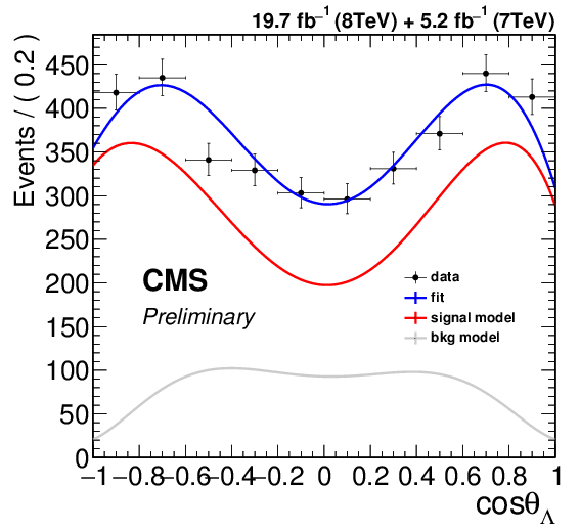
png pdf |
Figure 7-c:
Distributions of m(J/ψ¯Λ), cosθp, cosθΛ, cosθμ (from a to d) for ¯Λb candidates in 2011 and 2012 datasets in m(J/ψ¯Λ)∈[5.56,5.68], with fit results superimposed. The signal (background) component is shown in red (gray). |

png pdf |
Figure 7-d:
Distributions of m(J/ψ¯Λ), cosθp, cosθΛ, cosθμ (from a to d) for ¯Λb candidates in 2011 and 2012 datasets in m(J/ψ¯Λ)∈[5.56,5.68], with fit results superimposed. The signal (background) component is shown in red (gray). |
| Tables | |

png pdf |
Table 1:
Functions describing the angular distribution of the decay Λb→J/ψΛ0, J/ψ→μ+μ−, Λ0→pπ−. |
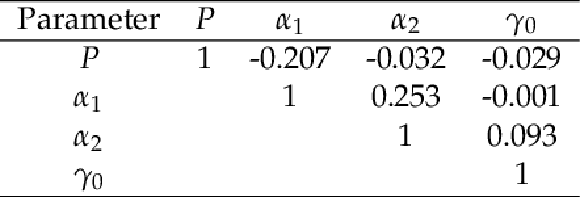
png pdf |
Table 2:
Correlation Matrix of the fitted parameters. |

png pdf |
Table 3:
Summary of systematic uncertainties. |
| Summary |
|
Based on an angular analysis of about 6000 Λb→J/ψ(→μ+μ−)Λ(→pπ−) decays collected by the CMS experiment in 2011 and 2012, we perform a measurement of the Λb polarization (P), the weak asymmetry parameter of the Λb decay (α1), the Λ0 longitudinal polarization (α2), and a measure of the longitudinal/transverse composition of the J/ψ meson (γ0). The measured values are α1=0.12±0.13(stat)±0.06(syst), α2=−0.93±0.04(stat)±0.04(syst), γ0=−0.46±0.07(stat)±0.04(syst) corresponding to the helicity amplitudes |T+0|2=−0.02±0.03(stat)±0.02(syst), |T−−|2=0.46±0.02(stat)±0.02(syst), |T++|2=0.05±0.04(stat)±0.02(syst) Our result of the Λb polarization is compatible with predictions from perturbative QCD calculations [21] for a polarization of ∼10% at 1.5σ, but it disfavors the 20% expectation reported in Ref. [22]. Also, as expected [11], our data analysis indicates a maximum longitudinal Λ0 polarization α2, or, equivalently, strongly suppressed transitions into the λΛ= 1/2 helicity states of the Λ baryon (T+0 and T++). |
| References | ||||
| 1 | T. Mannel and G. A. Schuler | Semileptonic decays of bottom baryons at LEP | PLB279 (1992) 194--200 | |
| 2 | A. F. Falk and M. E. Peskin | Production, decay, and polarization of excited heavy hadrons | PRD49 (1994) 3320--3332 | hep-ph/9308241 |
| 3 | ALEPH Collaboration | Measurement of Lambda(b) polarization in Z decays | PLB365 (1996) 437--447 | |
| 4 | OPAL Collaboration | Measurement of the average polarization of b baryons in hadronic Z0 decays | PLB444 (1998) 539--554 | hep-ex/9808006 |
| 5 | DELPHI Collaboration | Lambda(b) polarization in Z0 decays at LEP | PLB474 (2000) 205--222 | |
| 6 | B. Mele and G. Altarelli | Lepton spectra as a measure of b quark polarization at LEP | PLB299 (1993) 345--350 | |
| 7 | LHCb Collaboration | Measurements of the Λ0b→J/ψΛ decay amplitudes and the Λ0b polarisation in pp collisions at √s=7 TeV | PLB724 (2013) 27--35 | 1302.5578 |
| 8 | CMS Collaboration | The CMS experiment at the CERN LHC | JINST 3 (2008) S08004 | CMS-00-001 |
| 9 | P. Bialas, J. G. Korner, M. Kramer, and K. Zalewski | Joint angular decay distributions in exclusive weak decays of heavy mesons and baryons | Z. Phys. C57 (1993) 115--134 | |
| 10 | M. Kramer and H. Simma | Angular correlations in Λb→Λ+V: Polarization measurements, HQET and CP violation | NPPS 50 (1996) 125--129, .[125(1996)] | |
| 11 | T. Gutsche et al. | Polarization effects in the cascade decay Λb→Λ(→pπ−)+J/ψ(→ℓ+ℓ−) in the covariant confined quark model | PRD 88 (Dec, 2013) 114018 | |
| 12 | Particle Data Group Collaboration | Review of Particle Physics | CPC38 (2014) 090001 | |
| 13 | T. Sjostrand, S. Mrenna, and P. Z. Skands | PYTHIA 6.4 Physics and Manual | JHEP 05 (2006) 026 | hep-ph/0603175 |
| 14 | D. J. Lange | The EvtGen particle decay simulation package | NIMA462 (2001) 152--155 | |
| 15 | M. Brun, R. Hagelberg, and J. Lassalle | GEANT1 | CERN-DD-78-2-REV | |
| 16 | E. Gerchtein and M. Paulini | CDF detector simulation framework and performance | 2003 | |
| 17 | M. I. Rikova | Measurement of the Λb Polarization with pp Collisions at 7 TeV | CERN-THESIS-2013-218 | |
| 18 | CMS Collaboration | Measurement of differential cross sections versus pT and |y| of KS0, Λ0 and Ξ− from 7 TeV pp collisions at CMS | CMS-AN-10-084 | |
| 19 | W. Verkerke | The RooFit toolkit for data modelling | eConf C0303241, CHEP03 2003 | |
| 20 | ATLAS Collaboration | Measurement of the parity-violating asymmetry parameter αb and the helicity amplitudes for the decay Λ0b→J/ψΛ0 with the ATLAS detector | PRD 89 (May, 2014) 092009 | |
| 21 | G. Hiller, M. Knecht, F. Legger, and T. Schietinger | Photon polarization from helicity suppression in radiative decays of polarized Lambda(b) to spin-3/2 baryons | PLB649 (2007) 152--158 | hep-ph/0702191 |
| 22 | Z. J. Ajaltouni, E. Conte, and O. Leitner | Λ0b decays into Λ−vector | PLB614 (2005) 165--173 | hep-ph/0412116 |

|
Compact Muon Solenoid LHC, CERN |

|

|

|

|

|

|